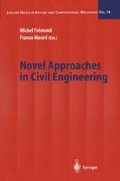Abstract
This paper deals with passive vibration damping of piezoactuated elastic structures. An enhanced resonant shunt electric circuit, which is a generalization of the shunt circuits proposed in the literature until now, is analyzed from a theoretical point of view. A modal model is used to evaluate the performances of this shunt in damping structural vibrations; in particular, a numerical optimization of the electrical components is performed according to the pole placement technique. It is shown that the new circuit presented here is able to partially improve the performances of the shunt circuits previously proposed in the literature.
Access this chapter
Tax calculation will be finalised at checkout
Purchases are for personal use only
Preview
Unable to display preview. Download preview PDF.
References
Agnes, G. S. (1995) Development of a modal model for simultaneous active and passive piezoelectric vibration suppression. J. Intell. Mater. Syst. Struct. 6, 482–487
Blanguernon, A., Lené, F. and Bernadou, M. (1999) Active control of a beam using a piezoceramic element. Smart Mater. Struct. 8, 116–124
Bisegna, P. and Caruso, G. (2000) Mindlintype finite elements for piezoelectric sandwich plates. J. Intell. Mater. Syst. Struct. 11, 14–25
Bisegna, P., Caruso, G. et al. (2000) Semi-active control of a thin piezoactuated structure. SPIE Proc. 3989, 300–311
Caruso, G. (2000) Laminati piezoelettrici, modellazione, algoritmi di calcolo ed ottimizzazione della risposta dinamica. Doctoral Thesis, Dep. of Civil Engineering, University of Rome “Tor Vergata”.
Caruso, G. (2000) Smorzmento passivo di vibrazioni mediante materiali piezoelettrici e circuiti elettrici risonanti. Proc. XXIX National Congress AIAS, Lucca, Italy, 307–316
Chandrashekhara, K., Shyser, C. P. and Agarwal, S. (1998) Dynamic modeling and neural control of composite shells using piezoelectric devices. J. Intell. Mater. Syst. Struct. 9, 29–43
Edberg, D. L., Bicos, A. S. and Fechter, J. S. (1991) On piezoelectric energy conversion for electronic passive damping enhancement. Paper GBA-1, Proceedings of Damping, San Diego, CA
Ghiringhelli, G. L. (1997) Structural vibrations and noise reduction by piezoelectric active control. J. Struct. Control 4, 41–68
Lam, K. Y. and Ng, T. Y. (1999) Active control of composite plates with integrated piezoelectric sensor and actuators under various dynamic loading conditions. Smart Mater. Struct. 8, 223–237
Lesieutre, G. A. (1998) Vibration damping and control using shunted piezoelectric materials. Shock vibr. digest 30, 181–190
Hagood, N. W. and von Flotow, A. (1991) Damping of structural vibrations with piezoelectric materials and passive electrical networks. J. Sound Vib. 146, 243–268
Hollkamp, J. J. (1994) Multimodal passive vibration suppression with piezoelectric materials and resonant shunts. J. Intell. Mater. Syst. Struct. 5, 49–57
Inman, D. J. (1997) Vibration suppression trough smart damping. Proc. of the Fifth International Congress on Sound and Vibration, Adelaide, South Australia
Park, C. H., Kabeya, K. and Inman, D. J. (1998) Enhanced piezoelectric shunt design. Adaptive Structurs and smart material systems. Trans. ASME AD 57, 149–155
Park, C. H. and Inman, D. J. (1999) A uniform model for series RL and parallel R-L shunt circuits and power consumption. SPIE Proc. 3668, 797–804
Ryu, Y. H., Kim, J. and Cheong, C. C. (2000) Piezoelectric shunting estimation using electrical impedance models. SPIE Proc. 3989, 39–48
Wu, S. Y. (1996) Piezoelectric shunts with a parallel R-L circuit for structural damping and vibration control. SPIE Proc. 2720, 259–269
Author information
Authors and Affiliations
Editor information
Editors and Affiliations
Rights and permissions
Copyright information
© 2004 Springer-Verlag Berlin Heidelberg
About this chapter
Cite this chapter
Caruso, G. (2004). Passive Vibration Damping of Piezoactuated Structures by Using Enhanced Shunt Electric Circuits. In: Frémond, M., Maceri, F. (eds) Novel Approaches in Civil Engineering. Lecture Notes in Applied and Computational Mechanics, vol 14. Springer, Berlin, Heidelberg. https://doi.org/10.1007/978-3-540-45287-4_21
Download citation
DOI: https://doi.org/10.1007/978-3-540-45287-4_21
Publisher Name: Springer, Berlin, Heidelberg
Print ISBN: 978-3-642-07529-2
Online ISBN: 978-3-540-45287-4
eBook Packages: Springer Book Archive

